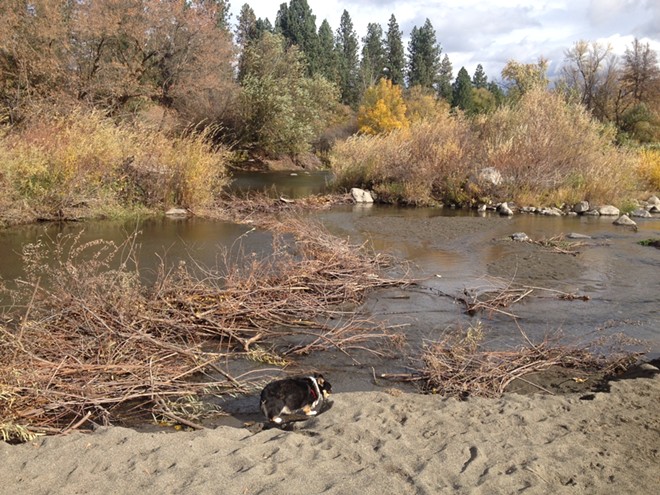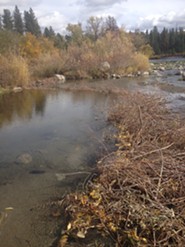Thursday, October 30, 2014
OUTLANDER: Beaver dams Hangman, oil trains, nuclear risks and Oregon wolves

OUTLANDER serves as a weekly round up of Inland Northwest outdoor recreation and natural resources news. This feature will highlight a wide variety of issues and events, ranging from camping stories to national environmental disputes. We’ll also try to include some scenic photos. Feel free to pass along suggestions or curiosities for celebrating the Great Outdoors.
—
Curved tangles of willow branches now span the mouth of Hangman Creek near People's Park as busy beavers have tried to take advantage of the lower autumn water flow. Joe Cannon, a restoration expert with The Lands Council, enthusiastically shared photos of the structures earlier this week as part of his mission to raise awareness of the critters' many beneficial impacts.
"I think it's great," he says. "[The beaver] is becoming acknowledged as an important piece of our natural [system]."
Cannon explains beavers work to thin out stream-side brush, slow water flows, filter out sediment and back up streams in ways that help expand wetland areas outward, improving habitat in many ways. The New York Times ran a story earlier this week about the renewed appreciation for the West's "ecosystem engineer."
The longer a dam can stay in place, the more it can contribute to habitat function. Cannon says unfortunately the Hangman Creek dam will likely get washed out by the often erratic flows through the waterway.
"It's just an incredibly flashy stream there," he says.
But he admires the creatures for trying. Cannon also appreciates the opportunity for the public to observe wildlife so intimately, so close to the city. He says he has received many excited or curious messages about the new dams.
We wrote about Cannon's work as an ambassador for beavers earlier this year, along with his efforts to minimize nuisance conflicts with property owners.
Cannon says he has spent much of the week camping out at an observation site because he feels the community needs to understand wildlife in order to best protect it. That involves recognizing their benefits and heading off disputes.
"The trick is keeping them out of trouble," he says.
IN OTHER NEWS: Hundreds of concerned citizens turned out to a public hearing on the safety and environmental concerns surrounding oil train shipments through Spokane. See photos from the hearing and rally. A new report finds close to 3,000 rail crossings in Washington that have never been inspected. (Inlander/NW News Network)
The Lands Council also hosted its fourth annual Reforest Spokane Day on Saturday. See photos from the tree-planting event. (Inlander)
The Nature Conservancy environmental protection group purchased 48,000 acres (larger than the city of Tacoma) of private timber holdings along I-90 near Cle Elum, including areas along Lake Kachess and Lake Keechelus. (Seattle Times)
A troubling draft report outlines severe worker safety concerns at Hanford Nuclear Site. (KING 5)
Environmental groups also plan to file suit over the nuclear site’s impact on the Columbia River and surrounding habitat. (AP)
The public serves as first line of defense in fighting poaching and other outdoor crime. (S-R)
Washington trails conference embraces diversity in users and urban spaces. (Crosscut)
An in-depth investigation of how anti-government sentiments threaten public land officers and employees. A related map shows three incidents in Washington, as well as a salt-shaker assault in Idaho. (HCN)
Washington fishery officials are considering new requirement for anglers to keep all hatchery catches. (Lewiston Trib via Oregonian)
Oregon is seeing increased tension between recovering wolves and residents. (WW)
Meanwhile, Oregon biologists mount unsuccessful expedition to re-radio collar popular OR-7 wolf. (Oregonian)
Mason County man charged for using excavator to illegally redirect Tahuya River. (WA AG)
Packing almost 600 pounds of gear for a remote, month-long National Geographic expedition. (NatGeo)
HALLOWEEN: Oregon farmer uses soil science to grow massive pumpkins. (USDA)
And some would argue Hollywood’s greatest horror villain has always been nature. (Outside)


















